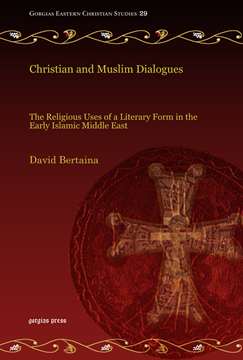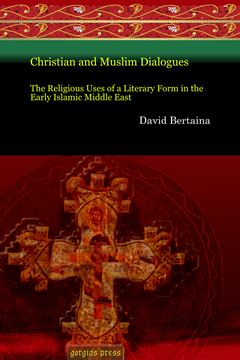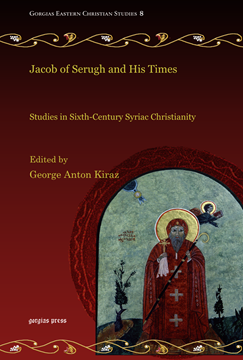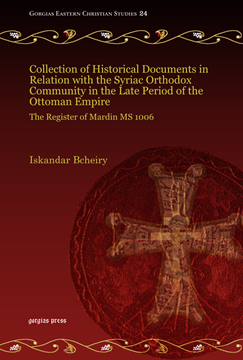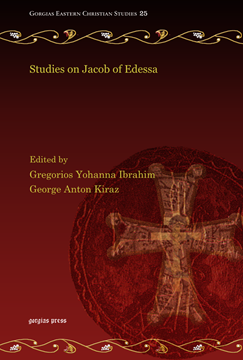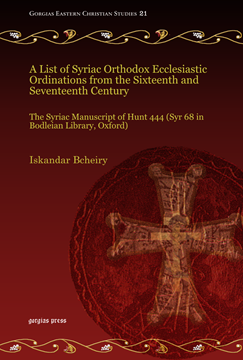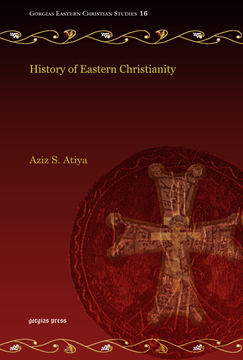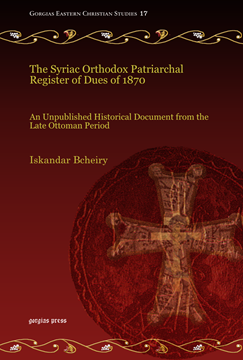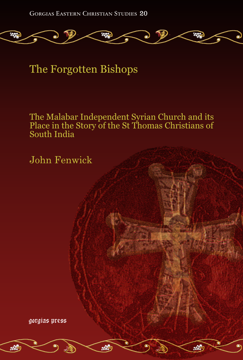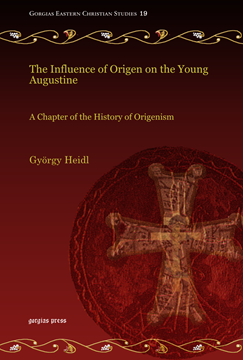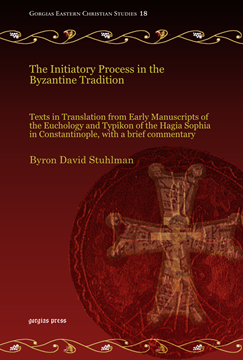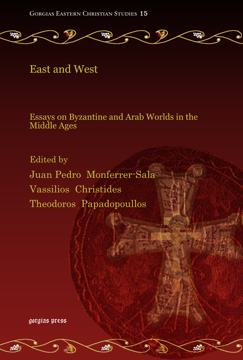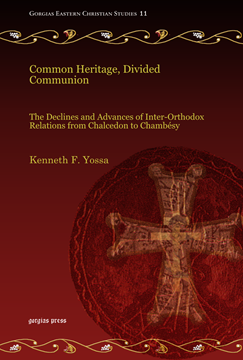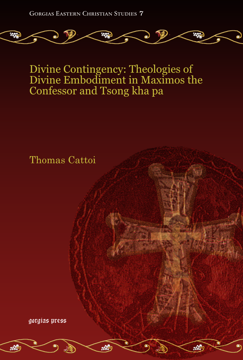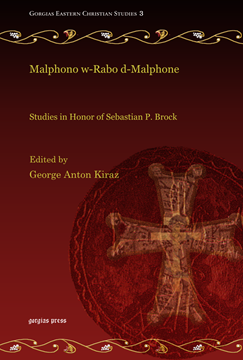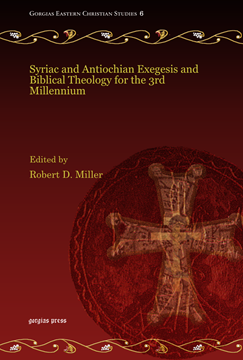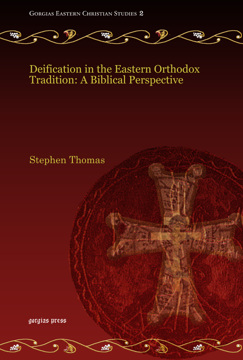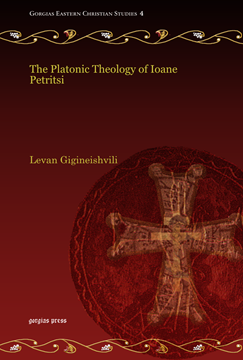Gorgias Eastern Christian Studies
Gorgias Eastern Christian Studies brings to the scholarly world the underrepresented field of Eastern Christianity. This series consists of monographs, edited collections, texts and translations of the documents of Eastern Christianity, as well as studies of topics relevant to the world of historic Orthodoxy and early Christianity.
Christian and Muslim Dialogues
The Religious Uses of a Literary Form in the Early Islamic Middle East
Series: Gorgias Eastern Christian Studies 29
ISBN: 978-1-61143-920-5
Linked by a common geography and claim to the true religion, Christians and Muslims had a long history of interreligious discourse up to the Crusades. These faith communities composed texts in the form of dialogues in light of their encounters with one another. This book surveys the development of the genre and how dialogues determined he patterns of conversation. Each chapter highlights a thematic feature of the literary form, demonstrating that Christian and Muslim authors did not part ways in the first century of Islamic rule, but rather continued a dialogue commending God’s faithful believers.
$188.00 (USD) $112.80 (USD)
Christian and Muslim Dialogues
The Religious Uses of a Literary Form in the Early Islamic Middle East
Series: Gorgias Eastern Christian Studies 29
ISBN: 978-1-61719-941-7
Linked by a common geography and claim to the true religion, Christians and Muslims had a long history of interreligious discourse up to the Crusades. These faith communities composed texts in the form of dialogues in light of their encounters with one another. This book surveys the development of the genre and how dialogues determined the patterns of conversation. Each chapter highlights a thematic feature of the literary form, demonstrating that Christian and Muslim authors did not part ways in the first century of Islamic rule, but rather continued a dialogue commending God’s faithful believers.
$101.00 (USD)
Jacob of Serugh and His Times
Studies in Sixth-Century Syriac Christianity
Edited by George Anton Kiraz
Series: Gorgias Eastern Christian Studies 8
ISBN: 978-1-60724-049-5
A collection of studies on the Syriac sixth century writer Jacob of Sarug by a team of international scholars, including Susan Ashbrook Harvey, Sebastian P. Brock, Sharbil Iskandar Bcheiry, Khalid Dinno, Sidney Griffith, Mary Hansbury, Amir Harrak, George A. Kiraz, Edward Matthews, Aho Shemunkasho, and Lucas Van Rompay.
$181.00 (USD) $108.60 (USD)
Collection of Historical Documents in Relation with the Syriac Orthodox Community in the Late Period
The Register of Mardin MS 1006
Series: Gorgias Eastern Christian Studies 24
ISBN: 978-1-60724-994-8
In the Ottoman Empire, Syriac communities kept their own baptismal books, marriage, funeral and other records and many of these can be found in various libraries, churches, monasteries in the West and East. The Syriac Garšūnī manuscript found in the Church of the Forty Martyrs in Mardin contains several lists of different subjects that go back to the late period of the Ottoman Empire. These lists, published here for the first time with annotations, are an important historical source for the social, economic, cultural and religious history of the Near East during the 19th century.
$153.00 (USD) $91.80 (USD)
The Demonstrations of Aphrahat, the Persian Sage
By Adam Lehto
Series: Gorgias Eastern Christian Studies 27
ISBN: 978-1-59333-768-1
Among the earliest known sources from the Persian Church, the 4th-century Demonstrations of Aphrahat reflect a form of Christianity much closer to its Jewish roots than contemporary Western forms. Their mix of ascetic instruction, polemic against Judaism, and theological reflection provides an invaluable glimpse into this otherwise poorly documented period.
$228.00 (USD) $136.80 (USD)
Redefining History on Pre-Islamic Accounts
The Arabic Recension of the Martyrs of Najrân
Series: Gorgias Eastern Christian Studies 26
ISBN: 978-1-61719-158-9
The account of the Martyrs of Najran has hitherto been known only through the Greek and the Syriac textual tradition, but this book offers an analysis of the original Arabic account to provide information about the most important details, and for identifying the original text of the Arabic version. A comparative study of the contents and structure of the tragic events which took place in the South Arabian city of Najran as they were narrated in the Arabic recension contained in the MS Sinaitic Arabic 535.
$155.00 (USD) $93.00 (USD)
Studies on Jacob of Edessa
Edited by Gregorios Yohanna Ibrahim & George Anton Kiraz
Series: Gorgias Eastern Christian Studies 25
ISBN: 978-1-60724-997-9
Jacob of Edessa was a seventh century polymath who witnessed the coming of Islam. In this collection of papers, specialists discuss the life and works of this figure with emphasis on the cultural landscape of the seventh century. Contributors include Sebastian P. Brock, Richard Price, Andreas Juckel, Alison Salvesen, Theresia Hainthaler, Amir Harrak, and Khalid Dinno.
$163.00 (USD) $97.80 (USD)
A List of Syriac Orthodox Ecclesiastic Ordinations from the Sixteenth and Seventeenth Century
The Syriac Manuscript of Hunt 444 (Syr 68 in Bodleian Library, Oxford)
Series: Gorgias Eastern Christian Studies 21
ISBN: 978-1-60724-621-3
The Bodleian Library in Oxford currently holds an unpublished historical document in Syriac containing precious historical information about the ordination of bishops, priests, monks, and deacons. Bcheiry gives the text and translation, and focuses on the importance of the data found in this historical list which he compares with other historical data found in other sources.
$158.00 (USD) $94.80 (USD)
History of Eastern Christianity
Series: Gorgias Eastern Christian Studies 16
ISBN: 978-1-60724-343-4
This book is a classic in the history of the Oriental Churches, which are sometimes portrayed as heretical in general church history books, if mentioned at all. Written by a Copt, it portrays the history of the faith of these non-Chalcedonian Churches with first-hand knowledge of their traditions. The author covers Alexandrine Christianity (the Copts and the Ethiopians), the Church of Antioch (Syriac Orthodox), the “Nestorian” Church of the East, the Armenian Church, the St. Thomas Christians of South India, the Maronite Church, as well as the Vanished Churches of Carthage, Pentapolis, and Nubia.
$230.00 (USD) $138.00 (USD)
The Syriac Orthodox Patriarchal Register of Dues of 1870
An Unpublished Historical Document from the Late Ottoman Period
Series: Gorgias Eastern Christian Studies 17
ISBN: 978-1-60724-427-1
This monograph presents an unpublished historical resource in the form of a register of dues collected for the Syriac Orthodox Patriarchate during the second half of the nineteenth century. Bcheiry provides the original text, an English translation, and an extensive socio-economic study.
$178.00 (USD) $106.80 (USD)
A Reassessment of the Evidence and a New Interpretation
Series: Gorgias Eastern Christian Studies 22
ISBN: 978-1-60724-074-7
This comprehensive study offers a critical, comparative analysis of the sources available on Bardaisan and a reinterpretation of his thought. The study highlights the profound points of contact between Bardaisan, Origen, and their schools; the role of Plato’s Timaeus and Middle Platonism in Bardaisan’s thought, and Stoicism. Bardaisan’s thought emerges as a deeply Christian one, depending on the exegesis of Scripture read in the light of Greek philosophy. Positive ancient sources present him as a deacon or even a presbyter, as an author of refutations of Marcionism and Gnosticism, and as a confessor of the faith during persecution.
$208.00 (USD) $124.80 (USD)
The Forgotten Bishops
The Malabar Independent Syrian Church and its Place in the Story of the St Thomas Christians of South India
By John Fenwick
Series: Gorgias Eastern Christian Studies 20
ISBN: 978-1-60724-619-0
The Malabar Independent Syrian Church is the smallest of the jurisdictions into which the St Thomas Christian community is divided today. It has, however, played a crucial role in the development of the Syrian Churches, whose stories can not be told without it. The present work shows how the bishops of this tiny, one-Diocese Church, now largely forgotten, once stood at the centre of the events that shaped the present ecclesiastical situation.
$257.00 (USD) $154.20 (USD)
The Influence of Origen on the Young Augustine
A Chapter of the History of Origenism
By György Heidl
Series: Gorgias Eastern Christian Studies 19
ISBN: 978-1-59333-702-5
The main purpose of the book is to demonstrate that as early as the first phase of his activity (386-393 AD), Augustine did make use of some Origenian works, and that basic elements of his early theology were derived from the Alexandrian master.
$219.00 (USD) $131.40 (USD)
The Initiatory Process in the Byzantine Tradition
Texts in Translation from Early Manuscripts of the Euchology and Typikon of the Hagia Sophia in Constantinople, with a brief commentary
Series: Gorgias Eastern Christian Studies 18
ISBN: 978-1-60724-430-1
This study provides an English translation of the texts for initiation in the Byzantine tradition, drawing on early manuscripts of the euchology and the typikon of the Great Church (Hagia Sophia). This includes texts for the enrollment of children in the rites of the eighth and fortieth days, catechesis and prayers during Lent, final preparations, including consecration of Chrism and the rites of apotaxis and syntaxis on Good Friday, Baptism at the Easter Vigil, postbaptismal rites and rites of closure, and provisions for the other baptismal feasts.
$170.00 (USD) $102.00 (USD)
East and West
Essays on Byzantine and Arab Worlds in the Middle Ages
Series: Gorgias Eastern Christian Studies 15
ISBN: 978-1-60724-056-3
Twenty-four contributions on matters dealing with Byzantine and Oriental lands, people, and cultures through different perspectives, including history, maritime trade, documents, travelers, and art. These essays trace the history of the relations between the Greeks and the peoples of the Middle East from Late Antiquity up to the seventeenth century.
$202.00 (USD) $121.20 (USD)
The Spell of the Logos
Origen’s Exegetic Pedagogy in the Contemporary Debate regarding Logocentrism
Series: Gorgias Eastern Christian Studies 10
ISBN: 978-1-59333-698-1
Origen’s construal of the Bible as a textual incarnation of the Word encourages an assimilationist interpretation of the Hebrew Scriptures as a proto-Christian gospel. Although in partial agreement with this thesis, this study suggests a non-assimilationist reading of Origen’s biblical exegesis.
$241.00 (USD) $144.60 (USD)
The Christian Heritage of Iraq
Collected papers from the Christianity of Iraq I-V Seminar Days
Edited by Erica C. D. Hunter
Series: Gorgias Eastern Christian Studies 13
ISBN: 978-1-60724-111-9
Iraq has been a centre of Syriac Christianity for almost two thousand years. This volume of collected papers from the Christianity in Iraq I-V Seminar Days (2004-2008) explores the Christian heritage of Iraq, highlighting the churches’ innate ability to transcend barriers of language, culture, ethnicity and religion.
$193.00 (USD) $115.80 (USD)
Common Heritage, Divided Communion
The Declines and Advances of Inter-Orthodox Relations from Chalcedon to Chambésy
Series: Gorgias Eastern Christian Studies 11
ISBN: 978-1-60724-067-9
Common Heritage, Divided Communion examines the various religious and secular events related to the Council of Chalcedon (451) and the so-called “Monophysite” schism. It includes a detailed overview and analysis of contemporary Eastern Orthodox and Oriental Orthodox ecumenical efforts to re-establish ecclesial communion.
$185.00 (USD) $111.00 (USD)
Divine Contingency
Theologies of Divine Embodiment in Maximos the Confessor and Tsong kha pa
Series: Gorgias Eastern Christian Studies 7
ISBN: 978-1-59333-970-8
This work explores the points of contact, as well as the differences between the distinct notions of divine embodiment developed by Maximos the Confessor (580-662), one of the greatest Greek Fathers, and Tsong kha pa (1357-1419), arguably the most important thinker in the history of Tibetan Buddhism. Both authors developed a spiritual theology where natural contemplation and the practice of the virtues are invested with a transformative value and are construed as a response to a cosmic intelligence, which sustains the universe, but also becomes manifest in history.
$193.00 (USD) $115.80 (USD)
Malphono w-Rabo d-Malphone
Studies in Honor of Sebastian P. Brock
Edited by George Anton Kiraz
Series: Gorgias Eastern Christian Studies 3
ISBN: 978-1-59333-706-3
A substantial Festschrift for Sebastian P. Brock, this volume contains 34 essays from a variety of scholars across the field of Syriac studies. The breadth of the submissions illustrates the multiplicity of approaches taken in contemporary Syriac studies, and while no overall limitations were set for the contributions, a lively interest in Jacob of Serug remains evident. No scholar in this discipline will want to miss this important collection that represents the latest in serious exploration of the world of Eastern Christianity in Late Antiquity.
$305.00 (USD) $183.00 (USD)
Syriac and Antiochian Exegesis and Biblical Theology for the 3rd Millennium
Edited by Robert D. Miller
Series: Gorgias Eastern Christian Studies 6
ISBN: 978-1-59333-487-1
The observation that scholarly work on the Bible is of little use to theologians is the starting premise for this volume. As a possible solution to this impasse, the contributors explore the potential insights provided by a distinct tradition of biblical interpretation that has its roots in both the patristic School of Antioch and in the Syriac Fathers, such as Ephrem and Jacob of Sarug, and which has survived and developed in the Churches of the Antiochene Patrimony, such as the Maronite and Syriac.
$156.00 (USD) $93.60 (USD)
Manuscrits Syriaques Conservés dans la Bibliothèque des Maronites d’Alep (Syrie)
Series: Gorgias Eastern Christian Studies 5
ISBN: 978-1-59333-956-2
The Maronite Library of Aleppo is one of the most important collections of manuscripts in Syria. This catalogue gives the first detailed description of the Syriac manuscripts, also containing images and indices of titles, personal names, subjects and places.
$167.00 (USD) $100.20 (USD)
A Biblical Perspective
Series: Gorgias Eastern Christian Studies 2
ISBN: 978-1-59333-638-7
A popularly-written study of the biblical roots of the Eastern Orthodox Church’s mystical understanding of the knowledge of God. This unique study brings together the best of contemporary exegesis with the tradition of Eastern Christianity and illustrates the biblical roots of the Eastern Church's understanding of grace as the energy of God. The book presents, in lay terms, the shape for an Orthodox biblical theology for the 21st century and will be of interest to all Christians for whom the Bible is divine revelation and for whom tradition continues to be creative.
$82.00 (USD) $49.20 (USD)
The Platonic Theology of Ioane Petritsi
Series: Gorgias Eastern Christian Studies 4
ISBN: 978-1-59333-395-9
Gigineishvili’s study is a comprehensive exposition of the philosophical system of twelfth-century Georgian Christian Neoplatonist philosopher Ioane Petritsi. Petritsi translated and commented on Proclus’ "Elements of Theology." The translation needed the creation of a philosophic language—a medium for transmitting the extravagant philosophic ideas into Georgian—which Petritsi effectively achieved. Petritsi both explains intricacies of Proclus’ thought and tries to prove the basic affinity between the Platonic and the biblical traditions. Gigineishvili exposes the entire system of Petritsi’s thought on a background of ideas of Proclus, other Neoplatonists, and of the Church Fathers.
$193.00 (USD) $115.80 (USD)
A Biblical Perspective
Series: Gorgias Eastern Christian Studies 2
ISBN: 978-1-59333-324-9
A popularly-written study of the biblical roots of the Eastern Orthodox Church’s mystical understanding of the knowledge of God. This unique study brings together the best of contemporary exegesis with the tradition of Eastern Christianity and illustrates the biblical roots of the Eastern Church's understanding of grace as the energy of God. The book presents, in lay terms, the shape for an Orthodox biblical theology for the 21st century and will be of interest to all Christians for whom the Bible is divine revelation and for whom tradition continues to be creative.
$173.00 (USD) $103.80 (USD)

